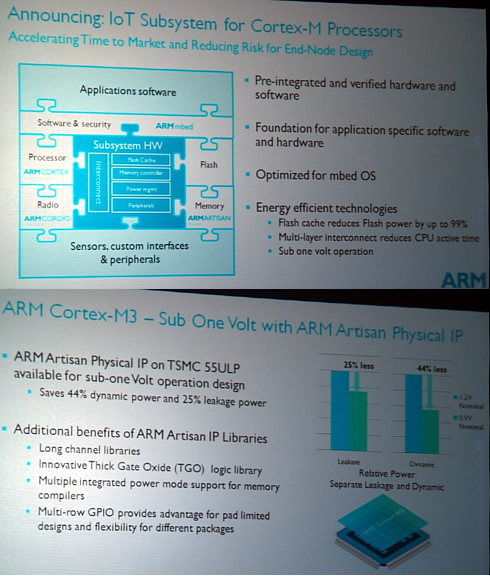
ARM Announces New Cortex-M Design For IoT Chips
ARM has unveiled a new hardware subsystem to enable the efficient development of customized chips for smart connected devices.
The british company has started licensing t he ARM IoT subsystem for ARM Cortex-M processors, which is optimized for use with ARM's efficient processor and radio technologies, physical IP and ARM mbed OS.
This subsystem IP block, together with Cortex-M processor and ARM Cordio radio IP, forms the basis for an IoT endpoint chip design, allowing ARM's partners to integrate sensors and other peripherals to create complete SoCs. Using ARM Artisan physical IP, the design is optimized for TSMC's 55nm Ultra-Low Power (55ULP) process technology with embedded flash memory, and will enable chips with reduced size, cost and power consumption, operating at sub one-volt.

 "With industry expectations of hundreds of billions of new smart connected sensors by 2030, we see a growing demand for highly customized chips," said James McNiven, general manager, systems and software, ARM. "Creating a highly tailored SoC is complex. The ARM IoT subsystem for Cortex-M enables companies to simplify the process and improve time to market. It enables our partners to focus finite design resources on the system functionality that differentiates them in their market."
"With industry expectations of hundreds of billions of new smart connected sensors by 2030, we see a growing demand for highly customized chips," said James McNiven, general manager, systems and software, ARM. "Creating a highly tailored SoC is complex. The ARM IoT subsystem for Cortex-M enables companies to simplify the process and improve time to market. It enables our partners to focus finite design resources on the system functionality that differentiates them in their market."
The ARM IoT subsystem for Cortex-M processors features a range of peripherals and interfaces; including links to TSMC's embedded flash memory. It is specifically designed for use with Cortex-M processors and optimized for mbed OS and Cordio Bluetooth Smart radio. It is possible to integrate other radios and wireless networking standards such as Wi-Fi and 802.15.4.
ARM developed this subsystem has been developed in collaboration with TSMC. The combination of Artisan physical IP and TSMC's 55ULP process means the subsystem can run at sub-one volt operation, extending battery life and making it easier to run a device using energy harvesting.





















